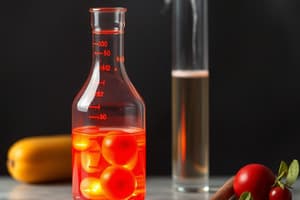Podcast
Questions and Answers
What is the primary source of energy for most biological systems?
What is the primary source of energy for most biological systems?
- Nuclear energy
- Solar energy (correct)
- Geothermal energy
- Chemical energy from food
During the absorptive state, which nutrient is primarily used by skeletal muscle for ATP production?
During the absorptive state, which nutrient is primarily used by skeletal muscle for ATP production?
- Amino acids (correct)
- Glucose
- Nucleic acids
- Lipids
Which of the following best describes catabolism?
Which of the following best describes catabolism?
- Synthesis of complex molecules
- Formation of glucose from non-carbohydrate sources
- Storage of energy
- Breakdown of molecules to release energy (correct)
What is the role of ATP in cellular processes?
What is the role of ATP in cellular processes?
Which metabolic reaction requires an energy input?
Which metabolic reaction requires an energy input?
The final products of aerobic cellular respiration include all of the following EXCEPT:
The final products of aerobic cellular respiration include all of the following EXCEPT:
Which organ uses glucose primarily for storage as glycogen during the absorptive state?
Which organ uses glucose primarily for storage as glycogen during the absorptive state?
Which statement about potential energy in nutrient molecules is true?
Which statement about potential energy in nutrient molecules is true?
What is the primary product of glycolysis?
What is the primary product of glycolysis?
Which hydrogen carrier is derived from Niacin (vitamin B3)?
Which hydrogen carrier is derived from Niacin (vitamin B3)?
During pyruvate oxidation, what is produced in addition to acetyl-CoA?
During pyruvate oxidation, what is produced in addition to acetyl-CoA?
What is the starting molecule of the Krebs cycle?
What is the starting molecule of the Krebs cycle?
How many protein complexes are involved in the electron transport system?
How many protein complexes are involved in the electron transport system?
Which process occurs at the ß-carbon during lipid metabolism?
Which process occurs at the ß-carbon during lipid metabolism?
What molecule is formed by the oxidation of citric acid in the Krebs cycle?
What molecule is formed by the oxidation of citric acid in the Krebs cycle?
What is released as a byproduct during the Krebs cycle?
What is released as a byproduct during the Krebs cycle?
Flashcards
Metabolism
Metabolism
The process of acquiring and utilizing energy from the environment.
Metabolic Processes
Metabolic Processes
The sum of all chemical reactions that occur within living organisms.
Catabolism
Catabolism
Breakdown of large molecules into smaller ones, releasing energy.
Anabolism
Anabolism
Signup and view all the flashcards
Aerobic Cell Respiration
Aerobic Cell Respiration
Signup and view all the flashcards
ATP (Adenosine Triphosphate)
ATP (Adenosine Triphosphate)
Signup and view all the flashcards
ADP (Adenosine Diphosphate)
ADP (Adenosine Diphosphate)
Signup and view all the flashcards
Glycogenesis
Glycogenesis
Signup and view all the flashcards
What is glycolysis?
What is glycolysis?
Signup and view all the flashcards
What is pyruvate oxidation?
What is pyruvate oxidation?
Signup and view all the flashcards
What is the Krebs cycle?
What is the Krebs cycle?
Signup and view all the flashcards
What is the electron transport chain?
What is the electron transport chain?
Signup and view all the flashcards
What is β-oxidation?
What is β-oxidation?
Signup and view all the flashcards
What are hydrogen carriers?
What are hydrogen carriers?
Signup and view all the flashcards
What is aerobic respiration?
What is aerobic respiration?
Signup and view all the flashcards
What is adenosine triphosphate (ATP)?
What is adenosine triphosphate (ATP)?
Signup and view all the flashcards
Study Notes
Metabolism of the Body
- Metabolism is the ability to acquire and use energy from the environment, encompassing all chemical reactions in cells, tissues, organs, and organ systems. All living things, from bacteria to humans, conduct metabolism.
- Two main types of metabolic reactions are catabolism (breaking down large molecules into simpler ones, releasing energy) and anabolism (building large molecules from simpler ones, requiring energy input).
Energy and Metabolism
- The energy powering most biological systems on Earth originates from solar energy.
- Plants capture solar energy for photosynthesis, producing their food.
- Food (carbohydrates, lipids, proteins, and nucleic acids) provides the energy for cellular processes.
- All molecules, including nutrients, store potential energy in the bonds between their atoms.
Metabolic Overview: The Absorptive State
- Nutrients are absorbed from the digestive tract and distributed in the bloodstream.
- Lipids are stored as triglycerides in adipose tissue, stimulated by insulin.
- Skeletal muscle utilizes absorbed nutrients for ATP production, also stimulated by insulin.
- All tissues (except skeletal muscle) use absorbed nutrients for ATP production, stimulated by insulin, growth hormone, and sex hormones.
- The liver and skeletal muscle store glycogen, stimulated by insulin.
- Absorbed nutrients are used for:
- Providing immediate energy for cellular processes like muscle contraction, secretion, and active transport.
- Synthesizing structural or functional molecules for cell repair and replacement.
- Storing energy as glycogen or fat for later use.
Cellular Respiration
- Aerobic cellular respiration, using oxygen, produces carbon dioxide, water, and energy.
- A portion of the generated energy is used to create ATP.
- The overall reaction is: Fuel Nutrient + O2 → CO2 + H2O + energy
ATP
- Catabolic reactions liberate energy stored in phosphate bonds of ADP, producing high-energy ATP molecules.
- ATP (adenosine triphosphate) is the universal energy carrier in cells.
- The reaction is: ADP + Pi + energy → ATP
Hydrogen Carriers
- Coenzymes NAD (nicotinamide adenine dinucleotide) and FAD (flavin adenine dinucleotide) carry energy and hydrogen.
- NAD is derived from niacin (B3), and FAD from riboflavin (B2).
- FAD accepts two hydrogen atoms (2H) to become FADH2.
- NAD accepts two electrons (2e) and one proton (H+) to become NADH + H+.
Carbohydrate Metabolism (Glucose)
- Glycolysis:
- Breaks down glucose (C6) into two pyruvic acid molecules.
- A metabolic pathway in the cytoplasm involving many enzymatically controlled steps.
Stage 2: Aerobic Respiration (Pyruvate Oxidation)
- Pyruvate is transferred to the mitochondria for oxidation.
- 2 pyruvic acids from glycolysis are converted into 2 acetyl-CoA molecules.
- Acetyl-CoA is crucial for entering the Citric Acid Cycle (Krebs Cycle).
- 2 CO2 and 2 NADH are produced.
Stage 3: Krebs Cycle
- Acetyl-CoA enters a cycle of 9 reactions, also known as the Citric Acid Cycle.
- The cycle is crucial for metabolizing glucose and requires 2 cycles.
- The cycle involves an initial reaction with oxaloacetic acid, producing citric acid.
- The cycle releases: CO2, free H+, & e- and forming ketoglutaric acid
- The process generates 3 NADH, 1 FADH2, and 1 ATP for each cycle of acetyl-COA.
Stage 4: Electron Transport System
- Located in the inner mitochondrial membrane.
- Includes four large protein complexes and ATP synthase.
- Flavoprotein (from riboflavin), Coenzyme Q (from Vitamin E), and Cytochromes (last: cytochrome a3) are components of the system.
- Electrons and hydrogen atoms from NADH and FADH2 are passed down a chain, creating a proton gradient.
- This gradient drives ATP synthesis by ATP synthase.
Lipid Metabolism
- Beta-oxidation:
- The pathway for breaking down fatty acids, occurring in the mitochondrial matrix.
- Fatty acids are broken down by breaking and rearranging connections in 2 carbon segments.
- Triglycerides:
- Major dietary lipids.
- Consist of a glycerol backbone and three fatty acids.
- Hydrolyzed (broken down) by lipase enzymes into glycerol and three individual fatty acids
Studying That Suits You
Use AI to generate personalized quizzes and flashcards to suit your learning preferences.




